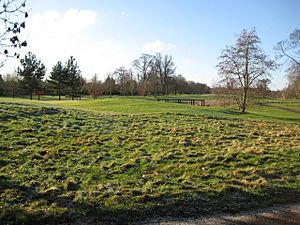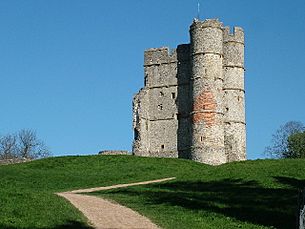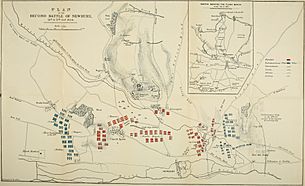Second Battle of Newbury facts for kids
Quick facts for kids Second Battle of Newbury |
|||||||
|---|---|---|---|---|---|---|---|
| Part of First English Civil War | |||||||
 Site of the battle, now Donnington Grove Country Club |
|||||||
|
|||||||
| Belligerents | |||||||
| Commanders and leaders | |||||||
| Charles I Prince Maurice |
Earl of Essex Earl of Manchester Sir William Waller |
||||||
| Strength | |||||||
| 8,500 3,500 cavalry 5,000 infantry |
19,000 7,000 cavalry 12,000 infantry |
||||||
| Casualties and losses | |||||||
| 1,500 | 2,000 | ||||||
The Second Battle of Newbury was a major fight during the First English Civil War. It happened on October 27, 1644, near Newbury, Berkshire in England. This battle took place close to where the First Battle of Newbury had been fought the year before.
In this battle, the combined armies of Parliament fought against the Royalist forces. Even though Parliament's side caused a lot of damage to the Royalists, they couldn't win a clear victory. This meant the battle ended without a definite winner.
Contents
Why the Battle Happened
In 1644, Parliament's armies had won some important battles. They also got help from Scottish allies. These victories made King Charles I's Royalist forces weaker around Oxford, which was his wartime capital.
Two Parliamentarian generals, the Earl of Essex and Sir William Waller, tried to trap King Charles near Oxford. But the King managed to escape. Later, Essex and Waller decided to split their armies, which was a big mistake. Waller chased the King, while Essex went to the west of England.
This allowed King Charles to return to Oxford and gather more soldiers. He then defeated Waller's army at Cropredy Bridge. Many of Waller's soldiers left, making his army much weaker. The King was then free to go after Essex's army.
Essex's army got trapped by the King's forces near the coast at Lostwithiel. Many of Essex's soldiers had to give up their weapons and equipment. While Essex himself escaped, his army was badly hurt. Only about half of his soldiers were ready to fight again.
The Armies Gather
After his victory at Lostwithiel, King Charles marched back across southern England. He wanted to help his isolated garrisons, like Donnington Castle near Newbury. Prince Rupert, who had lost a big battle in the north, briefly joined the King.
By October 19, the Earl of Essex had brought together three Parliamentarian armies. They positioned themselves to stop the Royalists from moving towards London. Waller, Manchester, and Essex all met up near Basingstoke.
On October 22, King Charles helped the soldiers at Donnington Castle. He even made their commander, John Boys, a knight. The King waited near Newbury for more of his troops to join him.
Battle Plans
King Charles's army held strong positions. They were at Donnington Castle, Shaw House, and the village of Speen. The River Kennet protected their southern side.
The Parliamentarian generals, Waller and Manchester, decided not to attack the Royalists head-on. They thought it would cost too many lives. Instead, they came up with a clever plan:
- Manchester would make a fake attack on Shaw House with 7,000 soldiers. This was to distract the Royalists.
- Waller would take 12,000 soldiers on a long, secret march around the Royalist position. He planned to attack Speen from the west.
- The idea was that when Waller's cannons fired, Manchester would then launch a full attack on Shaw House.
The Battle Begins

Waller's force started their long march on October 26. They continued on October 27 while Manchester began his distraction at Shaw House. The Royalists at Donnington Castle saw Waller's movement, but the soldiers at Speen were not warned.
Waller's army attacked Speen at 3 PM. They had cavalry led by Oliver Cromwell on one side and Sir William Balfour on the other, with infantry in the middle.
The Royalist soldiers at Speen were not ready. Even though they fought back at first, Parliament's infantry eventually captured the village and some cannons. Balfour's cavalry pushed back the Royalist cavalry. However, Cromwell was slow to act, and his side was pushed back by Royalist cavalry.
Meanwhile, Manchester was slow to start his main attack on Shaw House. He said he couldn't hear Waller's cannons over the noise of other artillery. Just before it got dark, Manchester finally attacked Shaw House, but his forces were pushed back.
Many soldiers were hurt or killed on both sides, but the numbers were about equal.
What Happened Next
The Royalists had stopped Parliament's attacks, but King Charles knew his army was too tired to fight another day. He was outnumbered and vulnerable. So, he quickly retreated north, leaving his injured soldiers and most of his supplies at Donnington Castle. The Parliamentarians did not block their escape route.
The next day, Parliament's commanders met. They decided to chase the King's army, but the Royalists had already crossed the River Thames and reached the safety of Oxford. The Parliamentarians then tried to attack Donnington Castle, but they were defeated with many losses.
By November 1, King Charles had more soldiers and was able to help Donnington Castle again on November 9. The Parliamentarians did not try to stop him this time. King Charles ended the fighting season with a success.
The Parliamentarian generals were divided and argued a lot after the battle. Cromwell and others were very unhappy that they had failed to trap King Charles. This dissatisfaction eventually led to important changes. Parliament passed the Self-denying Ordinance, which meant generals like Essex, Waller, and Manchester had to give up their commands. This led to the creation of the New Model Army, a new, more professional army that helped Parliament win the war the next year.
The Second Battle of Newbury was one of the few times in the English Civil War that an army tried such a wide move around the enemy. Waller and Manchester took a risk by splitting their army, but they knew they had more soldiers.


